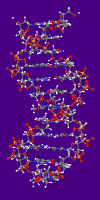Genetics
Genetics refers to the study of heredity, genes and genetic material. However, genetics is also a term used in contrast to genomics because of its traditionally lower- throughput, smaller- scale emphasis on single genes, rather than on many genes simultaneously as in genomics.
| We're all Homo here Evolution |
| Relevant Hominids |
| A Gradual Science |
| Plain Monkey Business |
v - t - e |
Mendel and his peas
Mendel's famous experiments with peas pointed the way to the information that results in visible traits being binary in nature. It has since been established that the DNA molecules in the nucleus of cells carry this information, on pairs of chromosomes. Of these pairs of chromosomes, in each living creature one originates from each parent (in the case of sexually reproducing species). This results in a continual mixing of traits present in a species across individuals.
Non-sexual gene transmission
Non-sexually reproducing organisms pass on genetic information to their offspring which is identical to their own, whether through division of single celled organisms like bacteria, or various forms of cloning used by many plants (budding, spreading via root systems, or layering of above-ground stalks that grow new roots and become independent). Many organisms, especially plants, are capable of sexual and asexual reproduction, with some alternating between the two from generation to generation.
Modern fields of study
Genetics has moved far beyond the simple tracking of traits from parent to child, however, from the identification of the DNA molecule by Watson, Crick, and Russell, through the modern sequencing of the human genome and the addition or subtraction of traits from existing species by genetic engineering.
Sequencing
Sequencing is the identification of the exact genetic code in the genome, in order to identify variant alleles, deletions and insertions.
Next-Generation 'high-throughput' sequencing machines can process large amounts of material, and are used for Whole Gnome Sequencing (WGS), whole exome sequencing (looking at the subset of the entire genome that 'codes' for genes) or other subsets of the genome that the scientists can tailor the 'kit' to match. A common approach uses 'shotgun sequencing', where the strands of DNA are broken up into chunks that are read by the machine in no particular order. Substantial computational effort is then needed to work out where each chunk belongs.
Sanger Sequencing is an older method, less suited to sequencing such large regions, but is considered the 'gold standard'. It is often used where the region of interest is small, such as when validating results obtained from next-Gen sequencing.
In all traditional sequencing methods, the genetic material is a blend of that from a number of cells. Ideally, these cells will be of the same kind and thus be interchangeable. This is not always the case in practice and can play hob with the analysis. In particular, tumour cells can be very different to their neighbours and those differences can have important consequences for treatment or diagnosis. A very recent development is that of single-cell sequencing, whereby single cells are isolated and sequenced separately. When it works, it provides higher quality analysis, better characterisation of tumours and reduces the need to 'purify' a sample down to a single cell type before sequencing, in cases where multiple cell types are of interest. When it works.
Gene Expression
Expression analysis takes a different approach, measuring the number of chunks associated with each particular gene rather than any variants within them. This measures differences in gene regulation between samples. This is generally done to test the difference in regards to two or more different environmental factors. This is your brain on drugs, indeed.
Polymerase chain reaction (PCR)

PCR is the straightforward process of amplifying a small amount of DNA in vitro, producing many copies. It is a simple extension of the DNA replication process. It involves a pair of primers (usually 20-30 bps in length) flanking the DNA target sequence. This allows a DNA polymerase enzyme to start the process of adding nucleotides (DNA polymerase needs a free 3' end to add nucleotides). The DNA polymerase used is usually Taq polymerase (isolated from the bacterium Thermus aquaticus, found in the hot springs in Yellowstone national park) as it is heat stable (although there are other heat stable DNA polymerase enzymes available, e.g. Pfu polymerase). The enzyme and primers are added into the reaction vessel, along with deoxynucleotide triphosphates and the template DNA (total reaction volume is usually about 50-100μL). This vessel is placed in a PCR machine, which runs for 30 cycles usually, with each cycle consisting of a denaturation at 94°C (DNA is denatured to allow primers access), annealing at 60°C (primers and free nucleotides hydrogen bond to complementary DNA) and an extension step at 72°C (DNA polymerase starts at the primer then moves along bonding free nucleotides together and forming a complimentary strand of DNA). This technique has had an immense impact on molecular biology, forensic science and the diagnosis of human genetic diseases.
Genetics before science
For thousands of years before the mechanisms were understood man has been genetically engineering, by selective breeding, food crops and domesticated animals to improve their flavor, yield, hardiness, and behavior.
Evolution
The genes that underlie the passing on of traits are one of the fundamental building blocks of the process of evolution.